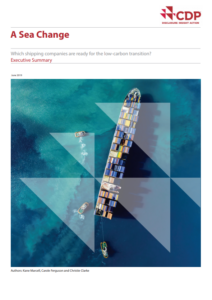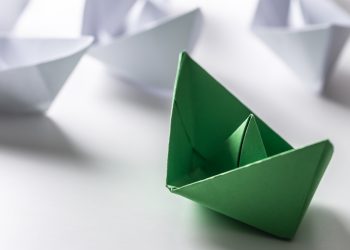The world’s shipping heavyweights are not investing enough in key technologies to cut their carbon footprint, with the sector risking not meeting IMO’s targets to reduce GHG by 50% by 2050. This is revealed in a new report ‘A Sea Change’ from the environmental non-profit and investment research provider CDP.
The report ranks 18 of the largest publicly listed shipping companies, representing US$62 billion of market capitalization, on business readiness for a low-carbon shift.
Shipping is responsible for up to 3% of global emissions and 10% of transport emissions. It is also a crucial part of the global economy, transporting about 80% of the world’s trade.
Marine freight is the least emissions intensive way of moving cargo, but freight demand is on the rise, which will require the sector to rapidly reduce its carbon emissions
CDP said.
[smlsubform prepend=”GET THE SAFETY4SEA IN YOUR INBOX!” showname=false emailtxt=”” emailholder=”Enter your email address” showsubmit=true submittxt=”Submit” jsthanks=false thankyou=”Thank you for subscribing to our mailing list”]
The report found that there is a gap between the cutting-edge carbon neutral technologies available to companies, and the forms of innovation they are developing. Namely, CDP’s analysis of marine innovations finds that only three are actively developing technologies that can have a transformative impact on the industry. Specifically, companies like NYK are working towards developing zero-emission vessels for 2050, whilst Maersk and NORDEN are actively pioneering the use of ‘second generation’ biofuels produced from waste sources such as cooking oil.
In addition, slow steaming can be an important short-term solution, able to reduce carbon emissions by as much as to 30%. In fact, 13 of the 18 companies have a formal slow steaming policy including K Line, HMM, Euronav and COSCO. Furthermore, slow steaming lead to more voyages to meet growing demand, eroding the emission reductions made by slowing down ships.
The research also concluded that while container companies are resilient to long-term decarbonization trends, they are facing further pressure as their customers want to cut emissions from their supply chain. On the other hand, bulk and tanker companies that transport fossil fuels and other commodities face risks from changes in demand for these products because of a wider decarbonization trends.

Carole Ferguson, Head of Investor Research, CDP commented:
Shipping companies are facing a sea change on the horizon. Based on current technologies, marine freight is one of the least emissions intensive modes of transport, therefore critical to the low-carbon transition. But as the global economy grows, the industry could account for 17% of global emissions by 2050, if nothing is done
Other key findings from the report include:
- Retrofitting existing fleets could be the most efficient strategy over the short term before more transformative technologies become viable – 14 companies show evidence of retrofitting which includes derating engines and the installation of new propellers;
- Low-carbon fuels – including biofuels, hydrogen and ammonia – can deliver significant emission reductions. However, these are underdeveloped with only Norden and Maersk showing evidence of supporting the development of second-generation biofuels;
- As a sector faced with low margins and high debt, it’s challenging to secure the required financing to innovate. This requires collaboration with Original Equipment Manufacturers;
- Liquified Natural Gas (LNG) plays a significant role as a transition fuel in the IEA’s below 2°C scenarios, presenting a growth opportunity for ships carrying LNG out to 2040;
- The shipping sector has poor rates of disclosure – only 5 companies in the universe completed CDP’s 2018 Climate Change questionnaire, and only 4 are official supporters of Mark Carney’s Task Force on Climate-related Financial Disclosures (TCFD);
- Board level oversight of climate issues is very low compared to other sectors. Only three companies have a formal climate committee at the board level.
Explore more information in the PDF herebelow































































